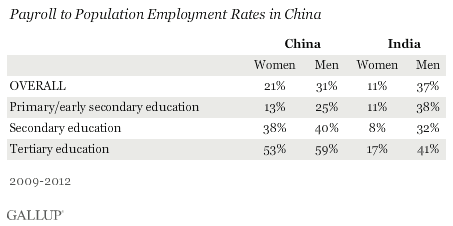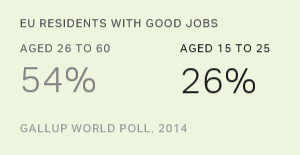WASHINGTON, D.C. -- Chinese women are taking part in their country's labor force in vastly greater numbers than Indian women are, according to Gallup surveys between 2009 and 2012. Overall, 70% of Chinese women are either employed in some capacity or seeking employment, vs. 25% of Indian women.

Gender gaps are also much narrower in China than in India, and all but disappearing among Chinese with the highest level of education. College-educated Indian women are significantly more likely than those who are less educated to be in the labor force; however, even among this group about one-third (34%) are in the labor force.
Not only do Indian women participate in the labor force at lower levels, those who do participate have a harder time finding jobs than women in China. Gallup's data indicate that, among Indian women who are labor force participants, 15% are unemployed -- meaning they are available for work and looking for jobs -- compared with 5% among India's male labor force participants. Among the much larger share of women in the Chinese workforce, 5% are unemployed.
Chinese Women Nearly Twice as Likely to be Employed Full Time for an Employer
The "working women" gap between China and India is also clearly reflected in Gallup's Payroll to Population metric, which shows the proportion of the total population that is employed full time for an employer and is not affected by changes in the workforce participation rate. The measure is more closely related to per-capita GDP than traditional employment figures.
Overall, Chinese women are about twice as likely as Indian women to work full time for an employer -- 21% vs. 11%, respectively. However, the differences are greater among women at higher education levels -- for example, 53% of Chinese women with tertiary education have a "good job," vs. 17% of highly educated Indian women. Particularly in China, women who attain higher levels of education are less likely to be self-employed and more likely to be employed full time for an employer.

The most recent UNESCO statistics put the literacy rate among Chinese females at 91%, approaching the 97% rate among Chinese men. This rate of literacy far exceeds that in India, where half of women are literate, along with three-quarters of Indian men. Indian women are less likely than Chinese women to receive even a basic education -- and those Indian women who do achieve higher levels of education are less likely to apply it in a full-time job.
Implications
The Chinese economy is currently outperforming India's: The World Bank put China's growth rate at 9.0% in 2011 and India's at 6.8%. But over the coming decades, demographic trends will pose a serious challenge for China's high-octane growth. Its aging population and low fertility rate means its workforce will shrink as a share of the total population by as much as 11% over the next 40 years, according to one estimate. In India, by contrast, the proportion of working-age people in the population is not projected to peak until around 2030.
However, women's participation in the formal economy will help determine how well India will be able to convert its "demographic bonus" into economic gain. Here, Gallup's global data demonstrate China has a distinct advantage: The country's female labor force participation is among the highest in Asia, while India's, like those of most south Asian countries, is among one of the lowest. The difference is most pronounced among more highly educated women, further supporting the notion that Chinese women contribute more to their country's "human capital" stock than Indian women.
Traditional cultural expectations have played a part in keeping educated women out of the labor force; as a recent World Bank report noted, throughout the South Asia region, "social norms for women's role in the economic sphere" may weaken their incentive to participate. In rural areas, higher fertility rates and less reliable access to schools have been important factors in why economic growth in India has not resulted in greater labor force participation for women.
Over the long run, there are reasons to think Indian women will be increasingly likely to participate in the country's labor force. One is that India's overall fertility rate has declined dramatically in recent decades and now stands at about 2.6 children born per woman. Another is that, as some researchers claim, India may be entering a historic urbanization phase as young people in particular move from predominantly rural states to the cities, where women have better access to education and large employers. In the near term, however, young Indian women also face high levels of youth unemployment and underemployment, which may discourage many from attempting to join the working world.
For complete data sets or custom research from the more than 150 countries Gallup continually surveys, please contact us.
Survey Methods
Results for India are based on face-to-face interviews with approximately 20,000 adults, aged 15 and older, conducted between 2009 and 2012. For results based on the total sample of national adults, one can say with 95% confidence that the maximum margin of sampling error is ±1 percentage point. Results for China are based on face-to-face interviews with approximately 17,000 adults, aged 15 and older, conducted between 2009 and 2012. For results based on the total sample of national adults, one can say with 95% confidence that the maximum margin of sampling error is ±1 percentage point. Error margins are higher for subsamples of the population who are employed or in the labor force. The margin of error reflects the influence of data weighting. In addition to sampling error, question wording and practical difficulties in conducting surveys can introduce error or bias into the findings of public opinion polls.
For more complete methodology and specific survey dates, please review Gallup's Country Data Set details.
